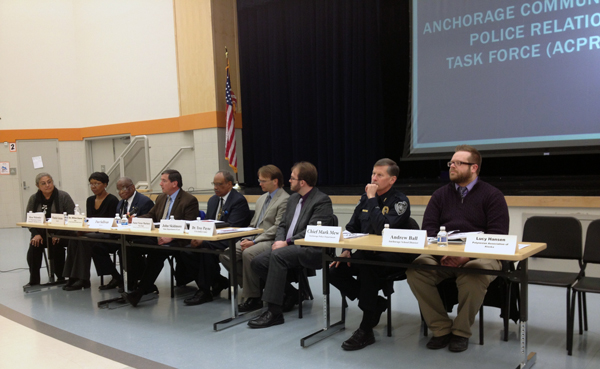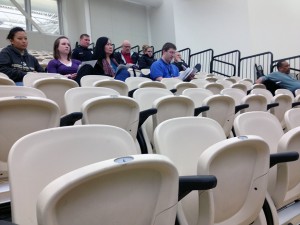
After 10 high profile officer-involved shootings over two years, the Anchorage Police Department has made their use-of-force policy public.
Police Chief Mark Mew made the announcement Thursday night in response to a recommendation from the Anchorage Community Relation’s Task Force.
Mayor Dan Sullivan requested the task force’s help after the string of officer-involved shootings, including one where a man wielding a stick was shot by an officer. Sullivan says the review is important.
“It’s important for us to communicate with the community why certain things happen, what the procedures are and also to be flexible and if there are changes that need to be made,” Sullivan said. “If in some cases, we’re too quick in using deadly force or in some cases the opposite, we want to be flexible enough as a department to adjust those policies and procedures and adjust our training accordingly.”

The forum on police use-of-force procedures signals the end of two years of review by the U.S. Department of Justice and Anchorage community leaders, which included community meetings, review of APD policy by the task force a University of Alaska Anchorage Justice Center study looking at 45 shootings over the past 20 years. APD released their use-of-force policy Thursday along with their entire policy manual. Police Chief Mark Mew says it just makes sense.
“The more we dug into it, the more we worked with community groups, the more we started asking ourselves, instead of just always trying to explain a policy that we don’t show people, why don’t we just show people the policy,” Mew said.
The task force made seven recommendations, including making the policy public. Mew says some tactical information will remain off limits, but the release of the department’s policies is a shift toward more transparency.
Since 2012, Rosa Melendez, the Regional Director for the U.S. Department of Justice community relations service in Seattle has been working with the police and community. She says APD’s policy release shows progress.
“And the fact that they’re not only putting the use-of-force policy up there but the entire manual is huge,” Melendez said. “It’s a huge leap of faith for the police department and I think it speaks volumes about the task force and the police department, the trust that they’ve gained with each other.”
The task force also recommends equipping every officer with a taser, standardizing reporting of use-of-force reports and making regular reports to the task force and the public. The task force also recommended that citizens do their part by attending APD’s Citizen’s Academy to better understand why police behave as they do and continuing to engage APD in meaningful discussions. Reverend, Doctor William Green who led the task force says he worries about the low turnout to Thursday’s event.
“You got to involve yourself in the community,” Green said. “Not wait until a crisis comes and everybody wants to picket and everybody wants to get upset. Alright. To prevent these kind of things, we have to participate.”
And Green says one way they can do that is by showing up at noon at the Fairview Rec Center, the second Friday of the month. He says that when the Anchorage Community Relations Task Force will continue to meet.
The use of force policy, along with the entire 600-page APD policy manual is now available on the department’s website.
Daysha Eaton is a contributor with the Alaska Public Radio Network.
Daysha Eaton holds a B.A. from Evergreen State College, and a M.A. from the University of Southern California. Daysha got her start in radio at Seattle public radio stations, KPLU and KUOW. Before coming to KBBI, she was the News Director at KYUK in Bethel. She has also worked as the Southcentral Reporter for KSKA in Anchorage.
Daysha's work has appeared on NPR's "Morning Edition" and "All Things Considered", PRI's "The World" and "National Native News". She's happy to take assignments, and to get news tips, which are best sent via email.
Daysha became a journalist because she believes in the power of storytelling. Stories connect us and they help us make sense of our world. They shed light on injustice and they comfort us in troubled times. She got into public broadcasting because it seems to fulfill the intention of the 4th Estate and to most effectively apply the freedom of the press granted to us through the Constitution. She feels that public radio has a special way of moving people emotionally through sound, taking them to remote places, introducing them to people they would not otherwise meet and compelling them to think about issues they might ordinarily overlook.




